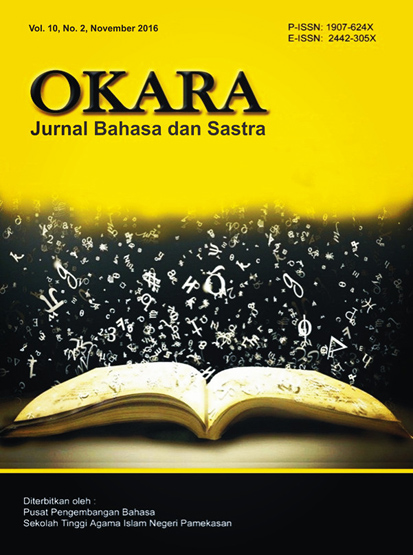PICTO-TEXT GLOSSES TO ENHANCE STUDENTS’ READING COMPREHENSION
 Abstract views: 282
,
Abstract views: 282
,
 PDF downloads: 157
PDF downloads: 157
Abstract
One of students’ difficulties in comprehending a reading text is their limited vocabulary. Therefore, this article is aimed to provide practical recommendation for EFL teachers to use picto-text (pictorial and textual) glosses in reading materials to help students’ become familiar to the terms used in the text that will eventually improve their reading comprehension.
Downloads
References
Baktiyan, A. 2014. The Effectiveness of Textual and Pictorial Glosses in Reading Comprehension and Vocabulary Mastery. Unpublished Master Thesis. Malang: PPs UM.
Brown, B. 2001. Studying the Use of Mobile Technology, in Brown, B., Green, N. and Harper, R. (eds) Wireless World: Social and Interactional Aspects of the Mobile Age, Springer, London, pp.3-13.
Brown, H. D. 2007. Teaching by principles: An interactive approach to language pedagogy. (3rd Ed.). White Plains, NY: Pearson Education.
Burns, C.P., Roe, D.B., Ross, P.E. 1996. Teaching Reading in Today’s Elementary School. USA. Houghton Mifflin Company.
Chun, D.M., & Plass, J.L. 1996. Effects of Multimedia Annotations on Vocabulary Acquisition. The Modern Language Journal, 80 (2), 183-198.
Dang, T.H. 2013. Towards the Use of Mobile Phones for Learning English as a Foreign Language: Hesitation or Welcome? Journal Language in India. (Online). www.languageinindia.com. Retrieved October 30, 2015.
Ghofur, Abd. “CREATIVE TEACHING.” OKARA JURNAL BAHASA DAN SASTRA 6, no. 2 (2012). http://ejournal.stainpamekasan.ac.id/index.php/okara/article/view/430.
Harmer, J. 2007. The practice of English language teaching (4th ed.). Edinburgh, UK: Pearson Education Limited.
Hartaty, W. 2014. Using Picto-Textual Glosses to Teach Reading: A Collaborative Action Research. In Cahyono, B.Y & Emaliana, I (Eds.) Success Stories in English Language Teaching and Learning. Malang: State University of Malang Press.
Hulme, A.K. 2007. Mobile Usability in Educational Contexts: What have we learnt? International Review of Research in Open and Distance Learning Volume 8, Number 2. (Online), (http://telearn.archives-ouvertes.fr/docs/00/19/00/26/PDF/356-3034-1-PB.pdf) retrieved October 30, 2015
Macceca, S. 2007. Reading Strategies for Science. Huntington Beach, USA: Shell Education.
Madiope, M. 2013. The feasibility of using audio podcast mobile technology to teach research writing in open distance learning: Case of University of South Africa. Unpublished Dissertation. (Online), (http://uir.unisa.ac.za /bitstream/handle/10500/11967/thesis_madiope_m.pdf?sequence=1) retrieved October 30, 2015.
Mayer, R.E., & Moreno, R. 2003. Nine Ways to Reduce Cognitive Load in Multimedia Learning. Educational Psychologist, 38 (I), 43-52.
Nuttall, C. 1996. Teaching Reading Skills in a Foreign Language. Oxford: Heinemann.
Richards, J.C. 2001. Curriculum Development in Language Teaching. Cambridge: Cambridge University Press.
Salem, E.B., & Aust, R. 2007. The Influence of Feature-Rich Computerized Glosses on Reading Comprehension and Vocabulary Acquisition. Proceedings of the Sixth IASTED International Conference on Web-Based Education held in Chamonix, France, March 14-17, 2007.
Saville-Troike, M. 2006. Introducing Second Language Acquisition. New York: Cambridge University Press.
Setyowati, Y. 2014. Mobile Comics As a Media to Enhance Literature’s Sense to Young Learners. The 61st TEFLIN International Conference, UNS, Solo.
Snow, C. 2002. Reading for Understanding: Towards an R&D Program in Reading Comprehension. Washington, DC: RAND Reading Study Group.
Sulistyo, G.H. 2011. Reading for Meaning: Theories, Teaching Strategies, and Assessment. Malang: Pustaka Kaiswaran.
Tomlinson, B. 2011. Introduction: Principles and Procedures of Materials Development. In B. Tomlinson (ed.) Materials Development in Language Teaching (second edition). Cambridge; Cambridge University Press, pp. 1-34.
Williams, M., & Burden, R. 1997. Psychology for Language Teachers. Cambridge. Cambridge University Press.
Yoshi, M., & Flaitz, J. 2002. Second Language Incidental Vocabulary Retention: The Effect of Text and Picture. CALICO Journal, 20 (1), p-p 33-58. Annotation Types.
Yanguas, I. 2009. Multimedia Glosses and Their Effect on L2 Text Comprehension and Vocabulary Learning. Language Learning & Technology, 13 (2), 48-67. Online. (http://llt.msu.edu/vol13num2/yanguas.pdf). Retrieved December 14, 2015.
Yansyah. 2014. Best Practices in Teaching Reading: Success Stories from Experienced Teachers. In Cahyono, B.Y & Emaliana, I (Eds.) Success Stories in English Language Teaching and Learning. Malang: State University of Malang Press.
The journal operates an Open Access policy under a Creative Commons Attribution-NonCommercial 4.0 International License. Authors who publish with this journal agree to the following terms:
- Authors retain copyright and grant the journal right of first publication with the work simultaneously licensed under a Creative Commons Attribution License that allows others to share the work with an acknowledgement of the work's authorship and initial publication in this journal.
- Authors are able to enter into separate, additional contractual arrangements for the non-exclusive distribution of the journal's published version of the work (e.g., post it to an institutional repository or publish it in a book), with an acknowledgement of its initial publication in this journal.
- Authors are permitted and encouraged to post their work online (e.g., in institutional repositories or on their website) prior to and during the submission process, as it can lead to productive exchanges, as well as earlier and greater citation of published work.





_(1).png)
.png)
.png)
1.png)
.png)
.png)

.png)
_-_Copy_-_Copy.png)





